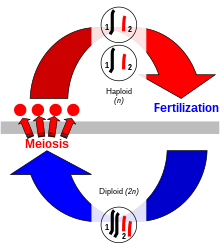Cell biology/Meiosis
Asexual vs. Sexual Reproduction
[edit | edit source]
Copied from WP: w:Sexual reproduction
- Asexual Reproduction
Aseuxal Reproduction: New individuals are created when a parent makes an exact copy of itself. Examples of this is in Mitosis, Binary Fission, Budding, etc.
- Sexual Reproduction
Sexual Reproduction: An individual is created when two haploid gametes (sex cells) join together during fertilization. Example: Meiosis.
Karyotype - Display of chromosomes pairs of a cell arranged by size and shape. Homologous chromosomes are a pair of chromosomes with the same length, centromere position, and staining pattern. They both contain genes of same characteristics. Karyotypes can be used to see defect chromosomes and if there are too many/little chromosomes, leading to a genetic disorder.
Sex chromosomes - X and Y chromsomes (not homologous).
Autosomes - Chromosomes that are not sex chromosomes. "See diploidchromosomes.PNG"
Fertilization - Union of haploid sex cells (gametes) --> diploid (zygote) [fertilized egg].
Reproductive Cells
[edit | edit source]
Somatic Cells: Body cells → Chromosome # in humans (2n) = 46
- Somatic cells are diploid in number meaning they have a full set of chromosomes. Abbreviated as 2N.
Gametes/Germ Cells: Sex cells → Chromosome # in humans (n) = 23
- Gametes are haploid in number meaning they only have half a set of chromosomes.
- Sperm (n) → Chromosome # = 23
- Ova = egg (n) → Chromosome # = 23
- Abbreviated as N
Homologous chromosomes: This is a pair of chromosomes in which each parent donates 1 chromosome to the pair.
- Locus - A specific area on the chromosome where a gene is located.
Meiosis
[edit | edit source]Meiosis is when a full set of chromosomes in a cell is cut in half through the separation of homologous chromosomes. This occurs in two parts: Meisois I and Meisois II.
- You could call Meiosis the "reduction division".
Spermatogenisis: The creation of four sperm cells through the process of Meiosis.
Oogenesis: Creation of an ova (egg) and three polar bodies through Meiosis.
- Tetrads and Crossing Over
- When each pair of chromosome pairs with its homologous chromosome they form a structure called a tetrad.
- Crossing Over - When tetrads are formed, homologous chromosomes may exchange portions of their chromatids (DNA). Results in a production of different sperm and egg (every sperm/egg is unique). Leads to better living conditions and survival of the species.
Stages of Meiosis
[edit | edit source]Meisois I
[edit | edit source]| Stage name | Description |
|---|---|
| Prophase I |
|
| Metaphase I |
|
| Anaphase I |
|
| Telophase I & Cytokenisis |
|
Meisois II
[edit | edit source]| Stage name | Description |
|---|---|
| Prophase II |
|
| Metaphase II |
|
| Anaphase II |
|
| Telophase II & Cytokinesis |
|
- Overall Diagram

Fertilization
[edit | edit source]When male and female sex cells, or gametes, (n=23) combine to create a diploid zygote (2n=46).
Diversity
[edit | edit source]- Crossing over in Prophase I allows the genes to interact with each other.
- Random Fertilization - Allows any random sperm to fertilize with an egg.
- Random Alignment of Homologous Chromosomes - Allows the chromosomes to separate, giving away to IA. Gives other hereditary characteritstics a fair chance to take place.
Comparison
[edit | edit source]| Description | Mitosis | Meiosis |
|---|---|---|
| Parent cell goes through how many divisions? | 1 | 2 |
| # of Daughter cells produced? | 2 | 4 |
| Type of Cells produced? | Body cells | Sex cells |
| Diploid (2N) or Haploid (N) cells? | Diploid (2N) | Haploid (N) |
| # of chromosomes in Humans | 46 | 23 |
| Daughter cells indentical or different from parent cell? | Identical | Different |
| Synonyms | Synonyms for body cells: Somatic Cells | Synonyms for sex cell: Gamete, Sperm, Egg |
- Why is mitosis necessary?
- To replace dead, worn out or damaged cells.
- So that an organism can grow and develop.
- Why is meiosis necessary?
- To create gametes (sex cells) necessary for fertilization.
- Increase genetic diversity in a population.
Diagram
[edit | edit source]
